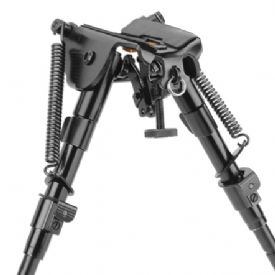|
Caldwell XLA 13" to 23" Pivot Model Bipod By Chuck Hawks and Mike Mackie  The XLA Pivot Model aluminum bipod is available in three heights. The version reviewed here, having legs adjustable between 13" and 23" in length, is the tallest. This makes it most suitable for use from the sitting, kneeling or squatting positions, depending on the shooter's body size and preference. It is also a useful size for shooting over the hood or trunk of a car, as varmint shooters sometimes do. This is the most expensive model in the Caldwell XLA bipod line, with a 2009 MSRP of $74.99. It weighs 16 ounces. Like most shooting bipods, the XLA attaches to the forend of the rifle by means of the front sling swivel stud. The bipod incorporates an alternative sling attachment stud. The legs have two sections and pressing in on the spring-loaded leg locks releases them to be extended or retracted. When not in use, the legs can be folded forward, where external springs keep them in place under tension. The ends of the legs are equipped with rubber feet that are stable and resist slipping on most surfaces. Thin rubber strips are glued to the base of the bipod to protect the forend of the rifle. The XLA Pivot Model has a couple of interesting features compared to other bipods we have used. The first is that the legs are notched at �" (2cm) intervals for easy indexing to a specific height. Since few shooters will be exactly the right size to use the bipod with its legs either fully extended or fully retracted, this is a major convenience in the field. When fully retracted, the bipod's legs compress a light coil spring that is concentric with the lower leg and click into place. This spring is mostly hidden inside the rubber foot. The next time the locking button is pressed to extend the leg, the leg springs out to the shooting position; another, if relatively minor, convenience. The most unusual feature is the "pivot" for which this model is named. The plate to which the rifle is mounted allows the rifle to be rolled up to 20 degrees to keep the scope's crosshairs level when the bipod is used on uneven ground, as it usually is in the field. A knurled tension knob and lock nut are provided at the rear of the mounting plate to control the amount of spring tension resistance for the pivot. Perhaps surprisingly, we found no unwanted play in the pivot mechanism. This is a very useful feature, one that we wish all bipods incorporated. There is also a fixed (non-pivoting) version of the XLA, but we definitely recommend the pivot model. Comparing the Caldwell XLA to a Harris 1A2-H of similar height that we had previously reviewed revealed similar construction, but a couple of significant differences. The Caldwell's legs splay wider than the Harris' and are not as rigid, although the aluminum tubing to form both are of similar outside diameter (approximately 0.500" upper and 0.375" lower). This is partly because, although the XLA's leg locks are faster and more convenient to use, they do not have thumbscrews to tighten them, as does the 1A2-H. The result is about 1/8" of in and out play at the locks when the XLA's legs are extended. Only gravity and the weight of the rifle atop the bipod serve to press the leg lock firmly against its stop. There is also a tiny amount of play where the XLA's legs attach to the mounting platform, which is absent in the Harris bipod. The difference in these structural details may have something to do with the fact that the XLA is made in Red China. Guns and Shooting Online contributor Mike Mackie took the XLA to a rifle range and performed some firing tests. Shooting from a bench rest and using inexpensive Remington/UMC ammunition, he found that his .22-250 varmint rifle, which wears a 16x scope, would shoot 1" groups at 100 yards. Shooting with the rifle mounted to the XLA, the average group size increased to 2". Mike attributed the difference primarily to loose manufacturing tolerances and the lack of positive leg locks. He feels that the XLA incorporates good ideas, but recommends that it be improved by the addition of bushings in the leg extensions and positive leg locks. As is, he regards it suitable for semi-auto .22 rimfires and AR-15 type rifles, but not for pinpoint accurate varmint rifles. Managing Editor Chuck Hawks compared the XLA to the aforementioned Harris 1A2-H in the field, mounted on a Remington Model 700 hunting rifle and a Savage Model 12 Varmint rifle. Shooting from sitting and squatting positions, he found the Harris to be somewhat steadier, but the Caldwell more convenient and faster to use. The difference in practical accuracy was actually slight and both were noticeably superior to shooting from similar positions without a bipod. Collapsing their legs and shooting with the bipods resting on the hood of a car, Chuck found both to be satisfactory in height, but the XLA's pivot feature made it the standout, since car hoods typically slope downward toward the front. With the Caldwell bipod, it was easy to keep the scope's crosshairs level, something nearly impossible to achieve with the Harris. The Caldwell XLA is offered in 6"-9", 9"-13" and 13"-23" heights and both pivoting and fixed platform models to suit any need. 2009 MSPR's range from $54.99 to $74.99. You can get yours from any Battenfeld Technologies dealer or online at www.battenfeldtechnologies.com. |